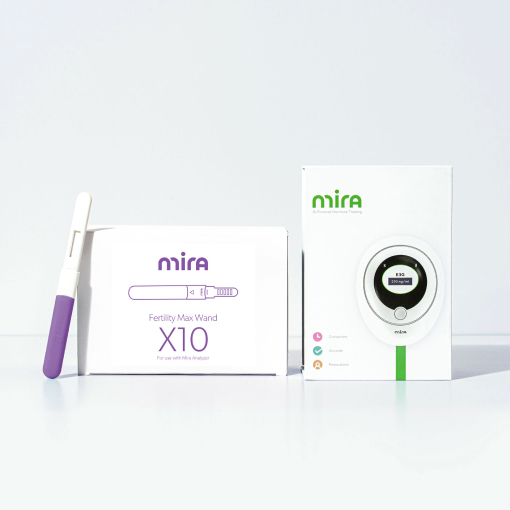Mira vs OPKs: Which is Right For You?
If you are trying to conceive or just curious about your body’s natural cycles you have probably done a little research into ovulation trackers. There are so many options out there so it can be confusing to know which one is right for you. In a new series of comparisons we will lay out the facts about some of your options so you can make an informed decision about this important aspect of your feminine health.

Let’s start with the most science-backed method out there – ovulation predictor kits or OPKs.
How they work
Both Mira and OPKs measure your luteinizing hormone (LH) in your urine to track ovulation. LH is an indicator of when you are most fertile because it peaks right before your ovaries release an egg.
Ovulation Prediction Kits
Ovulation prediction kits come in two forms: threshold-based and semi-quantitative tests. Threshold based tests give you a positive or negative result
to say whether you are above or below a set level of LH. This isn’t a personalized result, but based on a standard level. Therefore, if you have LH levels that are naturally different from the rest of the tested population then you might not be able to use a threshold based test.
Semi-quantitative tests measure LH levels and give you a number to signify a level of hormone. These levels are broken into ranges low, high, and peak. You can use this to track your LH pattern and how it changes over time. Knowing when your peak is will help you pinpoint your fertile window.
An OPK can give you between 12 and 48 hours advance notice of ovulation. Since these tests don’t give exact LH levels they don’t work well for people whose hormone levels run high or low.
Mira
Similar to other OPKs, Mira fertility tracker measures your LH levels over time. However, the Mira system tracks personalized information on par with what you would get at a doctor’s office without having to go in for weekly tests.
You receive the actual hormone concentration in your urine just like a doctor would. This is especially helpful if your levels deviate from the population averages and tend to run high or low throughout your cycle. The analyzer sends these results to the companion app and uses smart learning to track your cycle over time and help you pinpoint your most fertile days.

Can you use it with PCOS?
Most OPKs are designed with a normal textbook cycle in mind. For those that have cycles, LH concentrations, and conditions that deviate from what is considered a normal cycle, some OPKs won’t work well.
Polycystic ovary syndrome (PCOS) is a hormone condition common in women of reproductive age that can make it difficult to accurately track ovulation. Many women who suffer from PCOS have higher levels of LH throughout their cycle so there is not a surge within what is considered “normal levels” for the ovulation tracker to measure.
If you do use a semi-quantitative OPK to track your cycle and suffer from PCOS you do run the risk of getting false positives that you are ovulating. The OPK would read the high levels of LH as a sign that you are entering your fertile window.
Using a smart tracker such as Mira can eliminate false positives because the LH readings are not based on ranges or thresholds. By tracking your actual hormone concentration and learning your cycle over time it can better anticipate your fertile window and avoid false positives.
However, women who have PCOS often have a hard time conceiving and should discuss their individual condition and possible lifestyle changes with their healthcare team.
What about Advanced OPKs?
Advanced OPKs are ovulation predictor kits that measure both estrogen and luteinizing hormones. By measuring both they can provide even more advanced notice of your fertile window. In a normal cycle estrogen peaks a few days before LH giving you a few more days of notice for your fertile window.
Advanced OPKs such as ClearBlue Digital Monitor, indicate your fertile window and ovulation with a smiley face display. The start of your fertile window is shown with a flashing smiley happy face as your estrogen level increases. Peak LH level is shown with a solid smiley face. When the smiley face starts flashing you know that you are a few days away from peak fertility.
Like regular OPKs, these tests measure based on a range of levels and not your individual hormone level. If you naturally have high or low estrogen and LH levels you might not be able to use these as a reliable ovulation tracking measure.
Mira Plus also measures estrogen in combination with LH, but provides numeric values instead of ranges. This allows for a more complete view of your cycle and means even if your hormone levels don’t fit what is considered “normal” levels you can track changes and peaks.
Finding the correct ovulation tracker for your needs is important. Trying to conceive is already a stressful time and you don’t want to be worrying about whether your OPK is giving you accurate information. It is also important to remember that these are simply data points in predicting ovulation and there are many other physical and lifestyle factors that play a role in conceiving.
Recommended for you
Navigate your fertility with peace of mind
Mira’s Editorial Process
All content produced by Mira meets stringent editorial standards, ensuring excellence and accuracy in language and medical precision. Every piece undergoes thorough fact-checking and review by qualified professionals. Check out our full editorial process to learn more.








